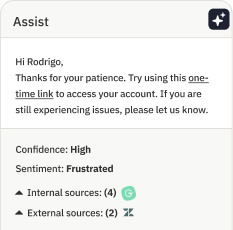How do you use Erlang C to plan staffing?

What is Erlang C? And how can it be used by support teams to make better staffing decisions? This article explains the basics.
The Erlang C formula is one of my favorite sources of call center trivia. Conceived of by Danish mathematician Agner Erlang in 1917, it was originally designed to model the number of switch operators needed to operate the burgeoning telephone system. Fast forward to 2020 and we’re still reaping the fruits of Agner's mathematical insight, with call centers and support teams commonly using the same model, with slight modifications, to forecast staffing requirements.
Why is Erlang C useful?
At its core, Erlang C allows you to model the relationship between staffing, call volume, and response time. These are factors that good support managers understand intuitively, but a little math goes a long way towards quantifying those intuitions.
Most often Erlang C is used to estimate required staffing for a given target response time and expected amount of contact volume. For more on how to estimate the latter, see our previous blog post on how to forecast for customer support. Many online calculators also factor in variables like shrinkage, occupancy, and concurrency. These additions make the formula flexible enough to model modern real-time channels like chat, SMS, and social media in addition to phone calls.
Note that in this post, we focus on staffing real-time channels. Erlang C is typically not appropriate for modeling channels like email, where response times may be in the hours or days and a backlog of tickets can build up over time.
How do you actually use Erlang C to plan staffing?
As discussed above, there are many calculators on the web that allow you to conduct Erlang analysis manually. Rather than go deep into the details of how Erlang C actually works, we'll focus on explaining how to interpret its results and use it to plan staffing.
Here are a few example calculations and how to interpret them. In the table below, the cells on the left represent inputs and the cells on the right represent calculations from Erlang. For example, if you receive 50 contacts per hour, contacts take 5 minutes to handle on average, and your goal is to respond to 90% of customers within 1 minute, then you'll need 10 people staffed in that hour and on average 60% of their time will be occupied with contacts. Note that we assume 30% shrinkage, which is fairly typical—this metric captures the portion of time spent on breaks, meetings, or any activities that don't involve directly handling customer contacts.
Here are a few other takeaways from the table:
- The value of scale really stands out. All else equal, baseline occupancy is much higher for a team receiving 150 contacts versus 50 contacts an hour. As a result, we often see teams with fewer than 20 people staff multiple channels at once or fall back to project-based and back-office tasks during down time.
- Reducing handle time has a big effect on reducing required staffing. As such, investments in tools and training that help the team solve customer issues more quickly are worthwhile. All that said, it's important not to single-mindedly optimize on speed, as both the customer experience and agent experience might suffer as a result.
- Improving response time requires a proportionally larger increase in staffing at a larger versus smaller team size. That is, it gets harder to respond quickly to customers as you grow. There are many ways to interpret this, but our optimistic view is that small teams can and should build a culture of excellence before they start to find themselves grappling with the challenges of scale.
Determining the right inputs
If this all seems like a lot of assumptions and variables, that's because there are indeed many factors to take into account. We suggest setting aside time to do research on industry averages for measures like shrinkage and occupancy, which are well studied. For other variables such as target response time, what makes sense for you will depend a lot on the characteristics and goals of your business—this is where judgment and tradeoffs come into play. Finally, metrics like handle time and forecasted volume are fairly science-driven. In these cases, you'll need to consult reporting and/or your data team to dive in.
As with any quantitative model, Erlang C is only as accurate as its assumptions, and so you absolutely do need to work off the right data in order to make the right decisions. As a brief illustration, we'll work off the same inputs as above (90% of responses within 60 seconds). If forecasts are off by 25%, you could find yourself understaffed or overstaffed by several people.
- 35 contacts → 8.5 agents at 49% occupancy
- 65 contacts → 13 agents at 60% occupancy
If you need help with making sure your inputs are solid, Assembled combines in-depth industry knowledge with seamless integrations to Zendesk, Kustomer, Intercom to pull the most accurate data. Please get in touch to learn more.
Making the hard decisions
At the end of the day, support teams need to make a number of hard decisions in order to balance serving customers promptly while maintaining economic viability. Erlang analysis removes some of the guesswork by clarifying how staffing decisions impact bottom-line customer-facing outcomes such as response time and service level. However, as we've shown, getting this right also requires having access to good data and projections.




